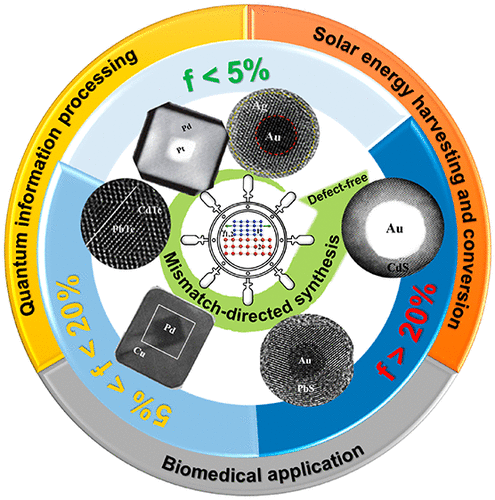当前位置:
X-MOL 学术
›
Chem. Rev.
›
论文详情
Our official English website, www.x-mol.net, welcomes your
feedback! (Note: you will need to create a separate account there.)
Nanointerface Chemistry: Lattice-Mismatch-Directed Synthesis and Application of Hybrid Nanocrystals.
Chemical Reviews ( IF 51.4 ) Pub Date : 2020-01-23 , DOI: 10.1021/acs.chemrev.9b00443 Jia Liu 1 , Jiatao Zhang 1
Chemical Reviews ( IF 51.4 ) Pub Date : 2020-01-23 , DOI: 10.1021/acs.chemrev.9b00443 Jia Liu 1 , Jiatao Zhang 1
Affiliation

|
In the past decades, great strides have been made in the synthesis of hybrid nanocrystals (HNCs) consisting of two or more disparate subunits (such as metals and/or semiconductors) joined through nanointerfaces, which are intriguing due to their exceptional functionalities that cannot be achieved by single-component nanosystems. The promising and versatile applications of these HNCs are closely dependent on the structural and electronic properties of the nanointerface between subunits. This is because the compatibility of the lattice structures between subunits not only determines the synthetic accessibility and growth mechanisms of the HNCs on the thermodynamic basis but also influences their interfacial characteristics (atomic arrangement, lattice mismatch-induced strain or defects), configurations, crystallinity, and the synergistic interplay of different subunits at the nanoscale. As a result, nanointerface chemistry has attracted intense scientific endeavors worldwide and spurred the rapid development of the lattice-mismatch-directed precise synthesis. This review gives an overview of the main strategies developed for delicate design and fabrication of core-shell HNCs under different degrees of lattice mismatch (from 0.2% to larger than 50%), including epitaxial seeded growth, nanoscale cation exchange, cation exchange-facilitated nonepitaxial growth, etc. Moreover, as for the core-shell HNCs with small (<5%) or moderate lattice mismatch (∼5-20%), the significance of the lattice-strain control at the nanointerface in maneuvering their functions toward desired applications are discussed in detail. Regarding the core-shell HNCs with large lattice mismatch (>20%), the challenges in precise synthesis, the promising solutions enabled by cation exchange-facilitated nonepitaxial growth, and the enhanced applications of the resulting HNCs with strain-free nanointerface are elaborated. We conclude with a personal perspective on the significance and urgency of fully harnessing the effects of lattice mismatch to further advance the science of synthesis and application of HNCs.
中文翻译:

纳米界面化学:晶格失配导向的杂化纳米晶体的合成与应用。
在过去的几十年中,由两个或多个通过纳米界面连接的不同亚基(例如金属和/或半导体)组成的杂化纳米晶体(HNC)的合成取得了长足的进步,由于其不可替代的出色功能,这令人着迷通过单组分纳米系统实现。这些HNC的有前途且用途广泛的应用紧密取决于亚基之间纳米界面的结构和电子特性。这是因为亚基之间晶格结构的相容性不仅决定了HNC在热力学基础上的合成可及性和生长机理,而且还影响了它们的界面特性(原子排列,晶格失配引起的应变或缺陷),构型,结晶度,以及在纳米尺度上不同亚基的协同相互作用。结果,纳米界面化学在世界范围内吸引了广泛的科学努力,并促进了由晶格不匹配定向的精确合成的快速发展。这篇综述概述了在不同程度的晶格失配(从0.2%到大于50%)下为核-壳HNC进行精细设计和制造而开发的主要策略,包括外延种子生长,纳米级阳离子交换,阳离子交换促进此外,对于具有较小(<5%)或中等晶格失配(〜5-20%)的核-壳型HNC,在纳米界面上控制晶格应变在操纵其功能朝着期望的方向转变方面的重要性。详细讨论了应用程序。关于晶格失配较大(> 20%)的核-壳HNC,阐述了精确合成中的挑战,阳离子交换促进的非外延生长所带来的有希望的解决方案以及具有无应变纳米界面的所得HNC的增强应用。我们以个人观点总结充分利用晶格失配效应以进一步推进HNC合成和应用科学的重要性和紧迫性。
更新日期:2020-01-23
中文翻译:

纳米界面化学:晶格失配导向的杂化纳米晶体的合成与应用。
在过去的几十年中,由两个或多个通过纳米界面连接的不同亚基(例如金属和/或半导体)组成的杂化纳米晶体(HNC)的合成取得了长足的进步,由于其不可替代的出色功能,这令人着迷通过单组分纳米系统实现。这些HNC的有前途且用途广泛的应用紧密取决于亚基之间纳米界面的结构和电子特性。这是因为亚基之间晶格结构的相容性不仅决定了HNC在热力学基础上的合成可及性和生长机理,而且还影响了它们的界面特性(原子排列,晶格失配引起的应变或缺陷),构型,结晶度,以及在纳米尺度上不同亚基的协同相互作用。结果,纳米界面化学在世界范围内吸引了广泛的科学努力,并促进了由晶格不匹配定向的精确合成的快速发展。这篇综述概述了在不同程度的晶格失配(从0.2%到大于50%)下为核-壳HNC进行精细设计和制造而开发的主要策略,包括外延种子生长,纳米级阳离子交换,阳离子交换促进此外,对于具有较小(<5%)或中等晶格失配(〜5-20%)的核-壳型HNC,在纳米界面上控制晶格应变在操纵其功能朝着期望的方向转变方面的重要性。详细讨论了应用程序。关于晶格失配较大(> 20%)的核-壳HNC,阐述了精确合成中的挑战,阳离子交换促进的非外延生长所带来的有希望的解决方案以及具有无应变纳米界面的所得HNC的增强应用。我们以个人观点总结充分利用晶格失配效应以进一步推进HNC合成和应用科学的重要性和紧迫性。










































 京公网安备 11010802027423号
京公网安备 11010802027423号